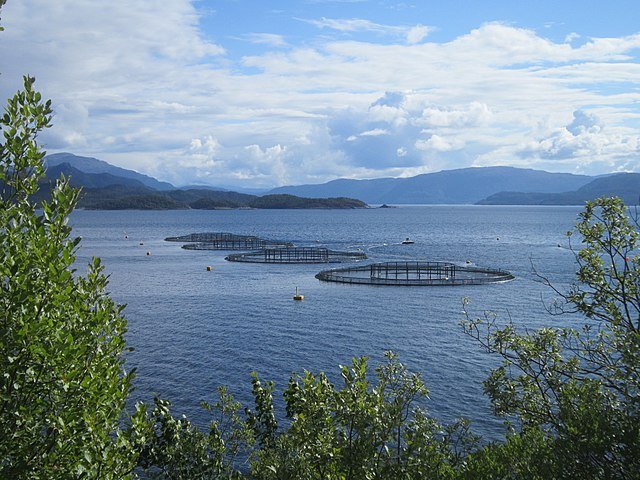
The increase in sea temperature and increasingly unpredictable weather patterns can create stressful conditions for fish raised in commercial sea-based aquaculture farms. This stress can affect the health of salmon and cause mass mortalities, impacting growth rates and overall aquaculture productivity.
A new study conducted by a team of scientists from Dalhousie University and Innovasea Marine Systems Canada establishes reference observations of fish physiology and Atlantic salmon (Salmo salar) behavior during two periods of high-risk thermal stress in summer and winter under commercial operations.
By understanding how these fish respond to thermal stress, salmon farmers can adapt their practices to create a more optimal environment, minimizing stress and maximizing production efficiency.
Finding the ideal temperature range
Scientists have an elegant way of measuring the temperature range that keeps a fish “happy”: it’s called aerobic scope. Imagine a fish has a certain amount of energy for activities like swimming and digestion. At ideal temperatures, this energy is readily available. But as temperatures rise too high, fish have to work harder just to keep up with their basic functions, leaving less energy for other things. The opposite occurs in very cold waters.
Biologgers: revealing salmon secrets
Researchers used a clever technique to directly observe salmon’s response to temperature changes in a real-world commercial environment: biologgers.
Small biologgers were surgically implanted in the fish to continuously monitor key physiological indicators for an impressive 245 days: practically a full production cycle! These high-tech devices captured information on external acceleration, depth, heart rate, and most importantly, temperature.
Studies using biologgers show that in nature, salmon actively seek comfortable temperatures, avoiding extremes.
The research utilized biologgers on a commercial salmon farm in Nova Scotia, Canada. By monitoring fish during high-risk summer and winter periods, scientists gained valuable insights into how salmon respond to temperature fluctuations. Additionally, environmental sensors and farm activity logs provided a comprehensive picture of the interaction between temperature, aquaculture practices, and fish welfare.
Stay Always Informed
Join our communities to instantly receive the most important news, reports, and analysis from the aquaculture industry.
Heart rate as an indicator of stress
The team of scientists focused on two key metrics: the apparent heart rate range and the Arrhenius breakpoint temperature:
- The apparent heart rate range essentially reflects the flexibility of a fish’s heart rate in response to temperature changes. A wider range indicates better adaptability.
- The Arrhenius breakpoint temperature marks the point at which metabolic processes begin to significantly slow down due to thermal stress.
The ideal point for salmon
Interestingly, both methods converged at the same “optimal point” temperature for Atlantic salmon: a chilly 12.7°C. This finding suggests that temperatures below 2°C and above 19°C start pushing fish toward their thermal limits, causing stress and potentially compromising their health.
What happens when things get too hot (or cold)?
The study also revealed that salmon experience stress when temperatures drop below 2°C or rise above 19°C. At these extremes, the apparent heart rate range decreased, indicating a struggle to maintain normal physiological functions. This highlights the importance of keeping farm temperatures within a comfortable range for fish.
Closing the gap: from lab to farm
This study represents a significant advancement in understanding how temperature affects Atlantic salmon in real-world aquaculture environments. Traditionally, this type of research relied on controlled laboratory settings. However, biologgers offer a powerful tool for directly observing fish behavior and physiology in commercial farms, providing crucial information for effective farm management.
By understanding the thermal optimum point of Atlantic salmon and how it responds to stress, salmon farmers can implement strategies to maintain optimal water temperatures. This could involve adjusting population densities, modifying feeding regimes during heatwaves, or even exploring innovative solutions like cooling systems on farms.
This research opens up new avenues by using biologgers to directly observe salmon, or other fish, in commercial aquaculture environments.
Conclusion
Key takeaways from the study include:
- Temperature matters: Keep your fish in their comfort zone (around 12.7°C) for optimal health and performance.
- Monitor closely: Biologgers provide valuable insights into how your fish responds to temperature changes.
- Adapt to change: By understanding thermal stress, you can adjust practices (e.g., adjusting feeding schedules) to minimize its impact.
By understanding how temperature affects the physiology and behavior of Atlantic salmon, this study allows farm managers to make informed decisions. This may involve adjusting aquaculture practices, such as selecting locations with more stable water temperatures or implementing strategies to cool warmer waters. Ultimately, this leads to healthier fish, a more sustainable aquaculture industry, and delicious, high-quality salmon for our tables.
Contact
Jennie Korus
Oceanography Department, Dalhousie University,
1355 Oxford Street, Halifax, Canada
Email: jennie.korus@dal.ca
Reference
Korus, J., Filgueira, R., & Grant, J. (2024). Influence of temperature on the behaviour and physiology of Atlantic salmon (Salmo salar) on a commercial farm. Aquaculture, 740978. https://doi.org/10.1016/j.aquaculture.2024.740978
Editor at the digital magazine AquaHoy. He holds a degree in Aquaculture Biology from the National University of Santa (UNS) and a Master’s degree in Science and Innovation Management from the Polytechnic University of Valencia, with postgraduate diplomas in Business Innovation and Innovation Management. He possesses extensive experience in the aquaculture and fisheries sector, having led the Fisheries Innovation Unit of the National Program for Innovation in Fisheries and Aquaculture (PNIPA). He has served as a senior consultant in technology watch, an innovation project formulator and advisor, and a lecturer at UNS. He is a member of the Peruvian College of Biologists and was recognized by the World Aquaculture Society (WAS) in 2016 for his contribution to aquaculture.




